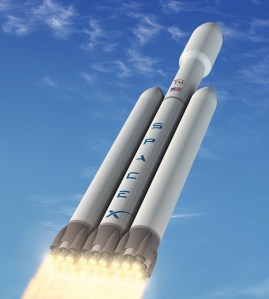
The NASA Space Shuttle Atlantis is nearing the end of the shuttle program’s final flight, and the United States is betting the next generation of American space flight will come from private commercial enterprises. Although efforts are already underway for private sub-orbital passenger service via Virgin Galactic, Elon Musks’ SpaceX is going in an entirely different direction: the firm has just broken ground at Vandenberg Air Force Base for a launch facility for its Falcon Heavy rocket.
When it’s completed, the Falcon Heavy will be the world’s most powerful rocket since the Saturn V vehicles that took Apollo astronauts to the moon, generating some 3.8 million pounds of thrust from 27 engines. The Falcon Heavy should also be the first vehicle to break the $1,000-per-pound pricing barrier for getting material to orbit—that’s about a tenth the cost of hoisting materials into orbit with the Space Shuttle—and the vehicle itself costs just a third of the price of the Boeing/Lockheed Delta IV Heavy, currently the workhorse of the commercial satellite and Department of Defense launches.
SpaceX hopes the Falcon Heavy—alongside the medium-lift Falcon 9—will be the go-to next-generation launch vehicles for everyone from the U.S. Air Force to NASA to the Department of Defense to commercial satellite operations.
“These are difficult fiscal times for our federal government and the Falcon vehicles can save the Department of Defense almost $2 billion per year in launch costs, while increasing reliability and capability,” said SpaceX CEO Elon Musk, in a statement. “This presents a great opportunity for the DoD to avoid canceling other programs and minimize reductions in personnel as budgets contract.”
The first Falcon Heavy is expected to get to Vandenberg by the end of 2012, with its inaugural flight to follow shortly thereafter.


